How to Practice Mindfulness: A Guide to Cultivating Presence
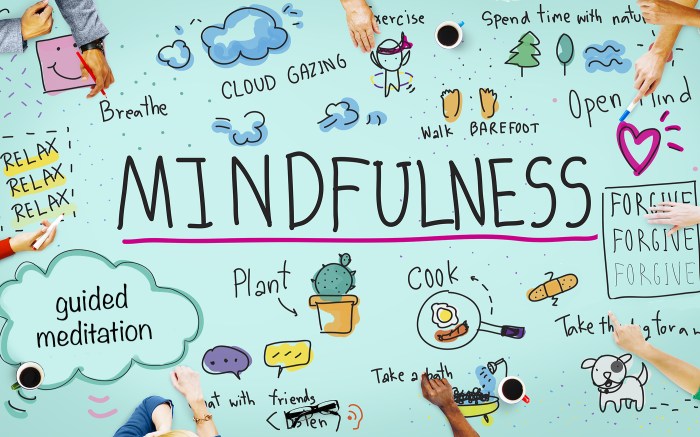
How to practice mindfulness is a question that resonates with many seeking a path to greater well-being and inner peace. Mindfulness, the practice of paying attention to the present moment without judgment, offers a powerful antidote to the constant chatter of our minds and the stress of modern life.
It invites us to step out of autopilot mode and experience life with fresh awareness, opening the door to greater clarity, focus, and emotional regulation.
This guide explores the core principles of mindfulness, delving into various techniques and practices that can be seamlessly integrated into your daily routine. From mindful breathing and body scan meditations to mindful movement and eating, we’ll journey through a spectrum of practices designed to enhance your awareness and cultivate a deeper connection with yourself and the world around you.
Understanding Mindfulness

Mindfulness is a practice that involves paying attention to the present moment without judgment. It is about being aware of your thoughts, feelings, and sensations without getting caught up in them. Mindfulness is a skill that can be cultivated through practice, and it can bring many benefits to your physical and mental well-being.
Core Principles of Mindfulness
The core principles of mindfulness can be summarized as follows:
- Present Moment Awareness: Mindfulness emphasizes being fully present in the current moment, rather than dwelling on the past or worrying about the future.
- Non-Judgmental Observation: It encourages observing thoughts, feelings, and sensations without labeling them as good or bad, right or wrong. This helps to reduce emotional reactivity and create space for acceptance.
- Acceptance: Mindfulness involves accepting things as they are, without trying to change or resist them. This includes accepting both pleasant and unpleasant experiences.
- Intention: Mindfulness is a practice that requires intention. It involves consciously choosing to pay attention to the present moment.
Benefits of Practicing Mindfulness
Practicing mindfulness can bring about a wide range of benefits, including:
- Reduced Stress and Anxiety: Studies have shown that mindfulness meditation can help to reduce stress hormones and promote relaxation.
- Improved Emotional Regulation: By observing your emotions without judgment, mindfulness can help you develop greater emotional awareness and regulate your responses to challenging situations.
- Enhanced Focus and Concentration: Mindfulness can help you train your mind to stay focused on the present moment, which can improve your attention span and concentration.
- Increased Self-Awareness: Mindfulness can help you become more aware of your thoughts, feelings, and behaviors, leading to greater self-understanding.
- Improved Sleep Quality: Practicing mindfulness before bed can help to calm your mind and improve the quality of your sleep.
Mindfulness vs. Meditation
Mindfulness and meditation are often used interchangeably, but there are some key differences:
- Meditation: Meditation is a broader term that encompasses various techniques for training the mind. It can involve focusing on a specific object, such as a mantra or breath, or cultivating a state of non-judgmental awareness.
- Mindfulness: Mindfulness is a specific type of meditation that focuses on paying attention to the present moment without judgment. It can be practiced in various ways, such as through formal meditation sessions, mindful walking, or mindful eating.
Mindful Breathing Techniques
Mindful breathing techniques are a cornerstone of mindfulness practice. They involve focusing your attention on your breath, allowing you to become aware of the present moment and cultivate a sense of calm and relaxation.
Benefits of Mindful Breathing
Mindful breathing exercises offer numerous benefits for both physical and mental well-being. These exercises can help to reduce stress, improve focus, and promote emotional regulation.
- Stress Reduction: When you practice mindful breathing, your body’s stress response is calmed. This is because deep, slow breaths signal to your nervous system that you are safe and relaxed.
- Improved Focus: By directing your attention to your breath, you train your mind to stay present and focused. This can enhance your ability to concentrate on tasks and improve your overall cognitive function.
- Emotional Regulation: Mindful breathing helps you become more aware of your emotions and develop the ability to manage them effectively. When you notice yourself feeling overwhelmed, you can use breathing exercises to calm your mind and body.
Types of Mindful Breathing Exercises
Various mindful breathing techniques can be incorporated into your practice. Each method offers unique benefits and approaches to cultivating awareness.
Box Breathing
Box breathing is a simple yet effective technique that involves inhaling, holding, exhaling, and holding your breath for equal durations, creating a box-like pattern.
Inhale for 4 seconds, hold for 4 seconds, exhale for 4 seconds, and hold for 4 seconds. Repeat this cycle for several minutes.
Alternate Nostril Breathing
Alternate nostril breathing, also known as Nadi Shodhana, involves breathing through one nostril at a time, alternating between the left and right nostrils. This technique is believed to balance the energy flow in the body.
Sit comfortably with your spine straight. Close your right nostril with your right thumb and inhale deeply through your left nostril. Close your left nostril with your ring finger and exhale through your right nostril. Inhale through your right nostril, close it with your thumb, and exhale through your left nostril. Continue alternating between nostrils for several minutes.
Finding a Quiet Space for Breathing Exercises
Creating a peaceful and comfortable environment is crucial for effective mindful breathing practice.
- Choose a Quiet Location: Find a space where you are unlikely to be disturbed. This could be a bedroom, a meditation room, or even a quiet corner in your home.
- Comfortable Posture: Sit or lie down in a position that allows you to relax and focus on your breath without strain.
- Dim the Lights: Reduce any distractions from bright lights by dimming the lights or using a soft lamp.
- Minimize Noise: If possible, create a quiet atmosphere by using earplugs or white noise to block out any external sounds.
Mindful Body Awareness

Mindful body awareness involves paying attention to the sensations in your body without judgment. It’s about becoming more aware of your physical self and how it feels in the present moment. This practice can help you cultivate a deeper connection with your body, reduce stress, and improve overall well-being.
Body Scan Meditation
Body scan meditation is a technique that guides you through a systematic exploration of your body, focusing on different parts and sensations. It’s a powerful way to develop mindful body awareness.
Steps for a Beginner’s Body Scan Meditation
This is a step-by-step guide for a beginner’s body scan meditation:
- Find a comfortable position, either sitting or lying down. Make sure you’re not too hot or too cold.
- Close your eyes or gently soften your gaze.
- Begin by focusing on your breath. Notice the rise and fall of your chest or abdomen. Simply observe the natural rhythm of your breath.
- Bring your attention to your toes. Notice any sensations, such as warmth, tingling, or pressure.
- Slowly move your attention up your feet, noticing any sensations in your ankles, calves, and knees.
- Continue to scan your body, moving upwards through your thighs, hips, and lower back.
- Pay attention to your abdomen, noticing any sensations in your stomach, chest, and back.
- Focus on your arms, noticing sensations in your hands, wrists, forearms, and shoulders.
- Bring your attention to your neck, noticing any sensations in your throat, jaw, and face.
- Finally, focus on your head, noticing any sensations in your scalp, forehead, eyes, and ears.
- If your mind wanders, gently bring it back to your body. There’s no need to judge yourself for getting distracted. Simply return to the practice.
- Continue scanning your body for as long as you feel comfortable. You can gradually increase the duration of your practice as you become more familiar with it.
Benefits of Paying Attention to Bodily Sensations
- Increased Body Awareness: Regular body scan meditation helps you become more attuned to your physical sensations, leading to a deeper understanding of your body.
- Stress Reduction: By focusing on the present moment and your physical sensations, you can detach from stressful thoughts and emotions, promoting relaxation and reducing stress levels.
- Improved Pain Management: Body scan meditation can help you manage chronic pain by increasing your awareness of your body and promoting a sense of acceptance towards pain.
- Enhanced Self-Regulation: Paying attention to your body can help you identify and manage physical reactions to stress, such as muscle tension or increased heart rate, allowing you to better regulate your emotions.
- Improved Sleep Quality: Body scan meditation can help you relax and prepare for sleep, leading to improved sleep quality.
Mindful Movement
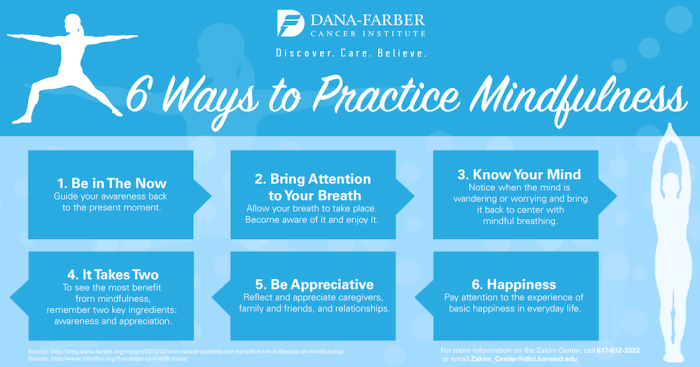
Mindful movement involves paying attention to your body’s sensations as you move, without judgment. It’s about being present in the moment and connecting with your physical self through intentional movement.
Benefits of Mindful Movement
Mindful movement offers numerous benefits, including:
- Improved Body Awareness: Mindful movement encourages you to tune into your body’s sensations, enhancing your awareness of posture, balance, and overall physical state.
- Stress Reduction: Engaging in mindful movement can trigger the release of endorphins, which have mood-boosting and stress-reducing effects.
- Enhanced Flexibility and Mobility: Practices like yoga and tai chi promote flexibility, range of motion, and improved balance, contributing to better overall physical well-being.
- Increased Focus and Concentration: Mindful movement can help calm the mind and improve focus, making it easier to concentrate on tasks and manage daily activities.
Examples of Mindful Movement Practices
Here are some examples of mindful movement practices that can be incorporated into your daily routine:
- Yoga: Yoga combines physical postures, breathing techniques, and meditation, promoting flexibility, strength, and mental clarity.
- Tai Chi: Tai chi is a gentle form of exercise that involves slow, flowing movements and deep breathing, promoting balance, coordination, and relaxation.
- Mindful Walking: Pay attention to the sensations of your feet on the ground, the rhythm of your breath, and the surrounding environment as you walk.
- Dance: Express yourself through movement, allowing your body to move freely and intuitively, connecting with your emotions and sensations.
Mindful Movement and Stress Reduction
Mindful movement can be a powerful tool for stress reduction. By focusing on your body and breathing, you shift your attention away from stressful thoughts and worries. The gentle movements and deep breathing associated with mindful movement practices help to calm the nervous system and promote relaxation.
“Mindful movement is not about achieving perfection or reaching a goal, it’s about the process of being present and aware in your body.”
Mindful Eating
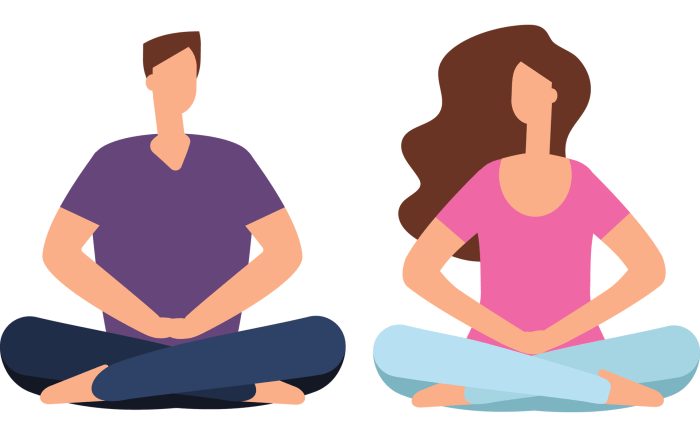
Mindful eating is a practice that involves paying full attention to the experience of eating, without judgment. It involves engaging all your senses in the process of eating, noticing the taste, smell, texture, and appearance of your food. It encourages you to eat slowly and savor each bite, allowing you to fully appreciate the experience.
Benefits of Mindful Eating
Mindful eating offers a wide range of benefits for both your physical and mental well-being. It can help you:
- Improve your relationship with food: By paying attention to your eating habits, you can develop a more balanced and healthy relationship with food. This can help you break free from emotional eating patterns and develop a more mindful approach to food choices.
- Manage your weight: Mindful eating can help you become more aware of your hunger and fullness cues, which can lead to more balanced eating habits and better weight management.
- Reduce stress and anxiety: The practice of mindful eating can be a powerful tool for managing stress and anxiety. By focusing on the present moment and engaging your senses, you can shift your attention away from worries and anxieties.
- Increase your enjoyment of food: Mindful eating allows you to truly appreciate the flavors and textures of your food, enhancing your enjoyment of each meal.
- Improve digestion: Eating slowly and chewing your food thoroughly can aid in digestion and prevent indigestion.
Tips for Practicing Mindful Eating, How to practice mindfulness
Mindful eating is a skill that can be developed with practice. Here are some tips to help you incorporate mindful eating into your daily life:
| Tip | Description |
|---|---|
| Choose a quiet and comfortable setting | Find a peaceful space where you can eat without distractions. Turn off the TV, put away your phone, and create a calm environment. |
| Focus on your food | Take a moment to appreciate the appearance, aroma, and texture of your food before you start eating. |
| Eat slowly | Take small bites and chew your food thoroughly. This allows you to savor the flavors and appreciate the textures. |
| Pay attention to your senses. | Notice the taste, smell, texture, and temperature of your food. Engage all your senses in the experience. |
| Listen to your body | Pay attention to your hunger and fullness cues. Eat when you are truly hungry and stop eating when you are comfortably full. |
| Avoid distractions | Minimize distractions while you eat. Put away your phone, avoid watching TV, and focus solely on your meal. |
| Practice gratitude | Take a moment to appreciate the food you are eating and be grateful for the nourishment it provides. |
Mindful Eating and Emotional Eating
Mindful eating can be a valuable tool for addressing emotional eating. Emotional eating occurs when you use food to cope with emotions such as stress, sadness, or boredom. By becoming more aware of your eating habits and the triggers that lead to emotional eating, you can learn to manage your emotions in healthier ways.
“Mindful eating is about paying attention to your food and your body, without judgment. It’s about noticing the flavors, textures, and smells of your food, and becoming aware of your hunger and fullness cues.”
Jan Chozen Bays
Mindful Communication
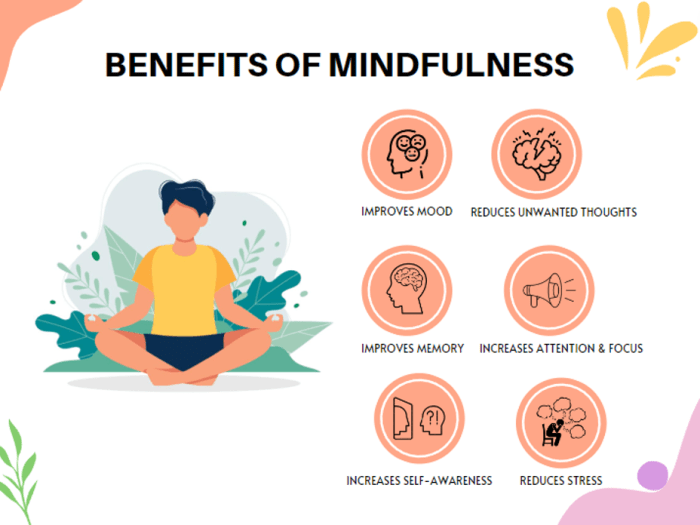
Mindful communication is a way of interacting with others that emphasizes presence, intention, and understanding. It’s about being fully present in the moment, listening attentively, and expressing yourself clearly and compassionately. In essence, it’s about creating a space for genuine connection and mutual respect in our relationships.
Importance of Mindful Communication in Relationships
Mindful communication is crucial for fostering healthy and fulfilling relationships. When we communicate mindfully, we create a foundation for deeper understanding, empathy, and connection. This approach can help us navigate challenging conversations, resolve conflicts constructively, and strengthen our bonds with loved ones.
Active Listening Techniques
Active listening involves paying full attention to the speaker, both verbally and nonverbally. It’s about being present, engaged, and receptive to the message being conveyed. Here are some techniques for practicing active listening:
- Maintain Eye Contact: Looking at the speaker shows that you’re paying attention and interested in what they have to say.
- Avoid Distractions: Put away your phone, turn off the TV, and create a space where you can focus solely on the conversation.
- Use Nonverbal Cues: Nod your head, smile, and maintain an open posture to show that you’re engaged and receptive.
- Paraphrase and Summarize: Repeating what you’ve heard in your own words helps ensure understanding and allows the speaker to clarify any misunderstandings.
- Ask Open-Ended Questions: Encourage the speaker to elaborate and share more by asking open-ended questions that go beyond simple “yes” or “no” responses.
Non-Judgmental Communication
Non-judgmental communication involves expressing yourself without resorting to criticism, blame, or negativity. It’s about focusing on your feelings and experiences without attacking or invalidating the other person’s perspective.
- Use “I” Statements: Instead of blaming the other person, take ownership of your feelings and experiences by using “I” statements. For example, instead of saying “You always make me feel bad,” try “I feel hurt when you say that.”
- Focus on the Present: Avoid bringing up past grievances or making accusations. Stay focused on the current situation and the feelings it evokes.
- Avoid Labeling or Generalizing: Refrain from using labels like “You’re always…” or “You never…” These generalizations can lead to defensiveness and escalate conflict.
- Validate the Other Person’s Feelings: Even if you disagree with their perspective, acknowledge and validate their feelings. This shows empathy and understanding.
Mindful Communication and Conflict Resolution
Mindful communication can be a powerful tool for resolving conflicts. By practicing active listening, non-judgmental communication, and empathy, we can create a safe and respectful space for dialogue and understanding. This approach can help us identify the underlying issues, find common ground, and reach mutually agreeable solutions.
Mindful Living: How To Practice Mindfulness
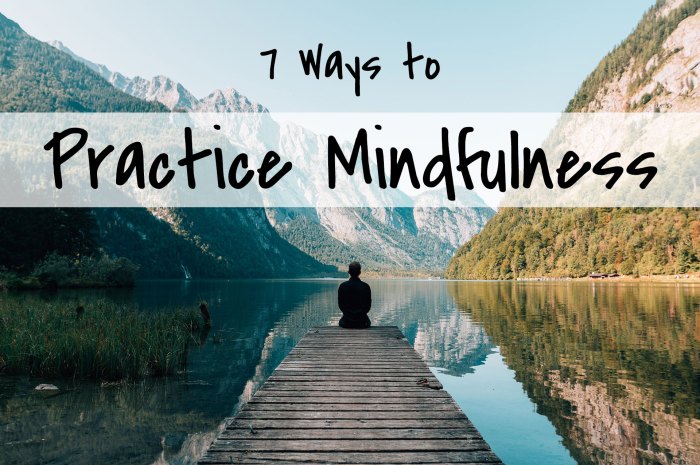
Mindfulness is not just a practice for meditation sessions; it’s a way of life that can be integrated into every aspect of your day. By bringing awareness to your thoughts, feelings, and sensations, you can cultivate a greater sense of presence and appreciation for the present moment.
This, in turn, can lead to increased well-being, improved relationships, and a more fulfilling life.
Integrating Mindfulness into Daily Routines
Integrating mindfulness into your daily life involves bringing conscious awareness to your everyday activities. This can be as simple as paying attention to your breath while brushing your teeth or savoring the taste of your morning coffee. Here are some tips for incorporating mindfulness into your routines:
- Start with small steps: Choose one or two activities you can focus on being mindful during the day. For example, you might start with mindful breathing while driving or mindful eating during lunch. As you become more comfortable, you can gradually expand your practice to other areas of your life.
- Be patient: Mindfulness is a skill that takes time and practice to develop. Don’t get discouraged if you find it challenging at first. Remember to be kind to yourself and celebrate your progress along the way.
- Create a mindful environment: Surround yourself with things that promote mindfulness, such as calming music, nature sounds, or inspiring quotes. You can also incorporate mindfulness practices into your home, such as setting aside a quiet space for meditation or creating a calming atmosphere in your bedroom.
- Use technology to your advantage: There are many apps and online resources available to support your mindfulness practice. Some apps offer guided meditations, while others provide reminders to be present throughout the day.
Mindful Practices for Work
Mindfulness can be a valuable tool for navigating the challenges of the workplace. It can help you manage stress, improve focus, and enhance communication. Here are some mindful practices for work:
- Mindful breathing breaks: Take short breaks throughout the day to focus on your breath. This can help you clear your mind, reduce stress, and improve your focus.
- Mindful movement: Incorporate light stretching or walking breaks into your workday. This can help you release tension and improve your energy levels.
- Mindful communication: Practice active listening when communicating with colleagues and clients. Pay attention to both their verbal and nonverbal cues to ensure effective understanding.
- Mindful problem-solving: When faced with a challenging task, take a moment to step back and observe the situation from a mindful perspective. This can help you identify creative solutions and approach problems with a calmer, more focused mindset.
Mindful Practices for Relationships
Mindfulness can enhance your relationships by promoting empathy, understanding, and compassion. Here are some mindful practices for relationships:
- Mindful listening: When engaging in conversations with loved ones, practice active listening. Pay attention to their words, tone of voice, and body language. This can help you understand their perspective and respond with empathy.
- Mindful communication: Communicate your thoughts and feelings clearly and respectfully. Avoid making assumptions or judgments about the other person’s intentions.
- Mindful presence: Make an effort to be fully present when spending time with your loved ones. Put away distractions and focus on connecting with them in the moment.
- Mindful forgiveness: Practice forgiveness, both for yourself and others. Holding onto anger and resentment can damage relationships. Forgiveness allows you to release negativity and move forward.
Mindful Practices for Personal Growth
Mindfulness can be a powerful tool for personal growth and development. It can help you gain insights into your thoughts, feelings, and behaviors, leading to greater self-awareness and self-acceptance. Here are some mindful practices for personal growth:
- Mindful self-reflection: Regularly take time to reflect on your thoughts, feelings, and actions. This can help you identify patterns and areas for improvement.
- Mindful journaling: Use a journal to record your thoughts and feelings. This can be a valuable tool for self-discovery and personal growth.
- Mindful gratitude: Practice gratitude by focusing on the positive aspects of your life. This can help you cultivate a more optimistic outlook and enhance your overall well-being.
- Mindful acceptance: Embrace the present moment, including both the good and the bad. Acceptance allows you to let go of resistance and embrace life’s challenges with greater ease.
Maintaining a Mindful Mindset Throughout the Day
Maintaining a mindful mindset throughout the day requires conscious effort and practice. Here are some tips for staying present and engaged:
- Set reminders: Use your phone or a physical reminder to check in with yourself throughout the day. Take a few moments to focus on your breath, scan your body for sensations, or simply observe your thoughts and feelings.
- Practice mindful movement: Incorporate mindful movement into your day, such as taking a walk, doing yoga, or engaging in a mindful exercise routine.
- Engage your senses: Pay attention to your senses throughout the day. Notice the sights, sounds, smells, tastes, and textures around you. This can help you appreciate the richness of the present moment.
- Be kind to yourself: Remember that mindfulness is a journey, not a destination. Be patient with yourself and celebrate your progress along the way.
Final Summary
Embracing mindfulness is an ongoing journey, a commitment to cultivating presence amid life’s complexities. As you explore these practices, remember that there is no right or wrong way to be mindful. The key lies in finding what resonates with you and consistently dedicating time to nurture your awareness.
Through regular practice, you’ll discover the transformative power of mindfulness, unlocking a sense of calm, clarity, and connection that enriches every aspect of your life.
Comments are closed.